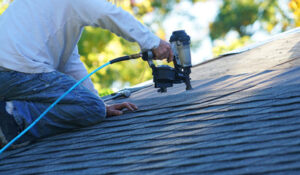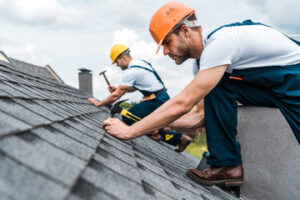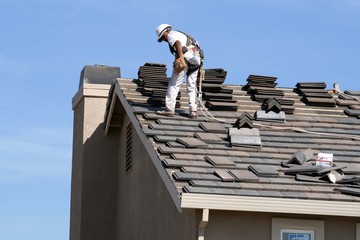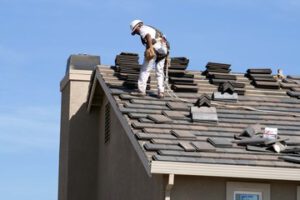Repairing a roof can mean anything from swapping out a few missing shingles to fixing leaks. It also includes cleaning the surface and removing moss and excessive mold growth.

However, if your home’s roof is nearing or past its expected lifespan, a replacement may be more cost-effective in the long run. Contact Roof Repair Murfreesboro TN for professional help.
Shingles and tiles are highly durable and meant to withstand a lot of wear and tear, but they’re not infallible. Severe weather, high winds, hail, and falling debris can damage or loosen them, leaving your home exposed to the elements. If you’re noticing any shingles or tiles are missing, it’s important to address this right away before the problem gets worse.
Missing shingles and tiles can leave your roof vulnerable to water penetration, resulting in rot and other serious structural issues. Leaking roofs can also lead to water stains on ceilings and mold within your home, as well as costly damage to interior walls, furniture, and flooring. Regular inspections by a professional will help you spot these signs and take action quickly.
Visible gaps or cracks in shingles and tiles are an obvious sign that they’re damaged or reaching the end of their lifespan. Other warning signs include curling or buckling, which are indicative of the roof’s instability. These problems can be addressed with a quick repair, but you’ll want to act promptly before these issues progress.
Taking a walk around your property can give you a good idea of the condition of your roof. From the ground, look for shingles that appear to be lifting or tearing, or that have lost their granules (which provide your roof with its primary layer of UV protection).
The most common cause of shingle and tile damage is severe weather. Tucson’s monsoon season can often result in strong winds that can damage or even lift shingles. Hailstorms can also knock off granules, creating visible bald spots on your roof.
A professional roofer will use PVC patch material to repair any leaking or damaged areas of your roof. First, they’ll cut a piece of patch material that extends 2 inches beyond the damaged area on all sides. Then, they’ll apply the patch to the damaged area, ensuring that the edges are properly rounded to prevent peeling. After the patch is firmly in place, they’ll carefully press down on the area to ensure it’s adhered correctly. They’ll also use a rubber roller to create a smooth, even surface.
Leaks
If water seeps through your roof, it can cause damage that requires a quick repair or even a complete replacement. The best way to prevent leaking is by regularly inspecting your roof for signs of deterioration and performing timely repairs.
The first sign of a leaky roof is usually water stains or pooling on the ceiling. The next step is to look around the house for further clues such as mold or mildew. Once you have found these, you can begin to figure out where the leak is coming from by heading up on the roof and doing a visual inspection.
Leaks often occur in areas where the roof meets other structures such as vents, chimneys, or dormer windows. The flashing that covers these areas can deteriorate from weathering or corrosion, leaving gaps through which water seeps. To prevent leaks, it is important to regularly inspect these areas and replace the flashing as needed.
Another common source of leaks is clogged gutters. If the gutters become clogged, water will stagnate on the roof and soak into your home through cracks and gaps. In order to prevent this, it is important to regularly clean out your gutters and keep them free of debris.
If you do find a leak, the best way to fix it is by using a waterproof membrane. This can be purchased at most roofing supply stores and is a great solution for metal roofs. Before applying the membrane, ensure the area is thoroughly cleaned and free of rust or any other contaminants that may interfere with the bonding process. Once applied, the membrane should be firmly secured to the roof and allowed to dry completely before exposing it to moisture.
Seeing leaks in your home is never a good thing, but it can be particularly dangerous if you try to perform the repairs yourself. Before heading up on the roof, make sure you prioritize safety by wearing appropriate footwear and personal protective equipment. Additionally, you should also know how to use a ladder safely. When you spot a leak, it is important to move any items that could be damaged by the water and put buckets under the affected area to catch the excess.
Sagging
Sagging roofs aren’t just a nuisance; they can lead to serious structural problems. Left unaddressed, sagging trusses and roof ridges can lead to further damage, increased repair costs, and even a collapsed roof. By recognizing the signs of roof sagging, homeowners can prevent further damage and keep themselves and their families safe.
While roofing materials are designed to last for decades, they degrade over time. Asphalt shingles lose their protective granules, and wooden beams and trusses can dry out, warp, or crack with age. Wood-eating pests such as termites, carpenter ants, and wood-boring beetles can also destroy the structural integrity of your roof, resulting in sagging. Regular inspections and prompt repairs are critical to avoiding these problems.
Damaged shingles and missing granules can allow moisture into the attic, where it may cause mold or mildew growth. Moisture can also penetrate the structure of your roof, causing rot and leaks. A sagging roof that’s allowing water to penetrate may require a roof replacement, or at the very least, a new set of shingles and flashing.
During storms, high winds can lift or tear off shingles and expose the wooden structures beneath. Heavy snowfall and rain may exploit these weaknesses, leading to sagging over time. In addition, debris such as branches or falling tree limbs can dent or break wooden trusses and rafters. Performing frequent roof inspections after storms and addressing any damage promptly can help avoid these issues.
The most common cause of sagging is structural damage to the joists, rafters, or ceiling trusses. This can be caused by natural wear and tear, water damage, or by improper installation. A professional roofer can inspect your roof for damage and recommend the best solution.
Homeowners can sometimes fix a sagging roof by installing support beams. However, this can be a complex and time-consuming process. It’s always a good idea to contact a professional roofer to ensure that the problem is resolved properly. A professional will be able to perform an in-depth inspection and identify the cause of the sagging, as well as any other issues that may need to be addressed.
Damaged Flashing
Flashing is a durable, waterproof metal sleeve around pipes, vents, chimneys and other protrusions on your roof. It’s also designed to seal joints and vulnerable areas like skylights, vents and chimneys, which can be susceptible to leaks and mold growth if damaged. It’s important to periodically check your flashing for signs of damage, rust or corrosion, cracks, gaps or missing pieces.
Visible cracks in your flashing may indicate it needs repair, especially if water penetrates these cracks and causes leaks or mold. Leaks and water stains on the ceiling or walls below the area of the crack can also be a sign that flashing is in need of repair.
A professional roofing contractor will examine the damaged flashing to identify the cause of the problem. If the problem is caused by an improper installation, the roofer will need to reinstall the flashing properly.
If the cracks are due to wear and tear, a roofing contractor can apply a roof sealant or caulk to fill the cracks. However, if the cracks are wide or show signs of deterioration, a flashing replacement may be needed.
Loose flashing may be easy to spot, as you’ll likely see visible gaps or cracks in the surrounding shingles and roofing material. It’s important to fix these cracks quickly before they get worse, as water can easily infiltrate the cracks and cause roof damage and interior leaks.
A professional roofer will use a pry bar and utility knife to remove any shingle material that is covering the damaged flashing. They’ll carefully remove the shingles to expose the flashing, which they’ll then replace and seal. The repair process will include cutting a new piece of flashing to size, nailing it in place and sealing the edges with roofing sealant to prevent water from seeping through.
Working at heights can be dangerous, especially if you don’t have the right tools and knowledge for proper roof repair. It’s often best to leave roof flashing repairs to the professionals, as they can be complicated and involve hard-to-reach areas of your roof. A professional will ensure the work is done correctly and that your roof is protected for years to come.



